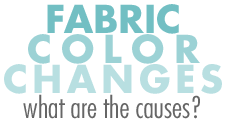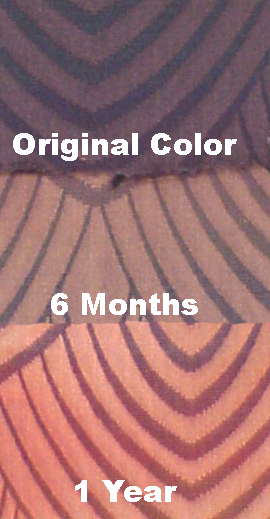
contributed by The Folks at Fiber-Seal
 Have you ever wondered why your white silk sofa seems to have a yellow cast” How about that white cotton sofa that is yellowing – but only behind the pillows” Most color changes do tend to occur on white or light-colored furnishings, but there can be problems on dark colors, too. There are many different causes for color change on fabrics. For the sake of simplicity, we will discuss only the six most common factors that contribute to the vast majority of the problems.
Have you ever wondered why your white silk sofa seems to have a yellow cast” How about that white cotton sofa that is yellowing – but only behind the pillows” Most color changes do tend to occur on white or light-colored furnishings, but there can be problems on dark colors, too. There are many different causes for color change on fabrics. For the sake of simplicity, we will discuss only the six most common factors that contribute to the vast majority of the problems.
Silicones
Color changes can also be caused by fabric protectors – specifically those containing silicone. Silicones have been known to cause yellowing of light-colored fabrics and carpets. The best products on the market today no longer contain silicones.
Flame Retardants
Flame retardants are used on both upholstery fabrics and on the ticking inside cushions. It is not uncommon for these chemicals to undergo changes over a period of time, creating damaging acids.
 Flame retardant damage may show up as yellowing or browning that occurs as spots or “splotches” on white or light- colored fabrics. It can also show up as dyes that change color, as shown here.
Flame retardant damage may show up as yellowing or browning that occurs as spots or “splotches” on white or light- colored fabrics. It can also show up as dyes that change color, as shown here.
Cleaning Chemicals
Cleaning chemicals can cause many types of color changes. The most problematic are those that contain some type of bleaching agent.
Sodium Hypochlorite (common household bleach) and benzoyl peroxide (found most often in acne medications) are the most common and among the most difficult bleaching problems to correct. Many of the newest spray-type household cleaning products now add bleach, so be sure to check labels and keep those products away from soft surfaces. Likewise, store medications well away from fibers.
Chemicals containing strong alkalis or acids can also cause a wide array of color changes. Some fabrics contain fiber reactive dyes that are easily damaged with the slightest pH change. If a fabric or rug has been treated with a fire retardant, the acids found in those products can sometimes cause color changes.
Another group of common household products that can cause color variation is insecticides. These products can sometimes cause very dramatic dye changes. We have seen a beige sofa turn a fluorescent green shortly after the house was bombed with an insecticide spray.
Natural Aging
Many fabrics change color simply through their own natural aging process. This is especially true of white or light- colored silk. You may have even heard the term “patina” used to describe the appearance of aging silk. While sunlight can accelerate the process, this yellowing is natural, though end users may not realize it until their white silk starts to take on a yellowish cast.
Optical Brighteners
This problem presents itself in two ways. First, and probably the most common, is the yellowing process of the optical brightener itself. As it ages and breaks down on fibers, yellow to yellow-brown blotching can occur.
Another type of problem is caused by spot cleaning with products containing optical brighteners. By applying the optical brightener in a concentrated area, the affected spot can often be seen as a light-colored or “bleached” spot.
Sunlight
By far the most common culprit in color change is sunlight. Particularly affected are silks and wools, but dyes in many fabrics can also be affected. Dyed silks bleach rapidly in direct sunlight. Indirect sunlight will eventually cause the same results; it will just take a little longer. Also, as discussed earlier, sunlight will speed the aging process of silk, causing rapid yellowing.
Wool is also affected by sunlight in two different ways. The first is known as photoyellowing. When subjected to indirect or direct sunlight, the wool fiber can turn yellow. Conversely, some wool will photobleach. White or light-colored wool can continue to get lighter or “bleach out.” There is no scientific way to tell whether wool will photoyellow or photobleach.
Prevention Tips
Here are some simple rules to follow to help preserve the useful life of upholstered furnishings and limit unwanted color changes:
1 | Rotate cushions and pillows on a regular basis. Don’t save the “good side” for company.
2 | Don’t use spotting chemicals that contain optical brighteners.
3 | Pull shades and draperies when appropriate so that direct sunlight is limited.
4 | Don’t use chemicals that contain either a strong acid or alkali.
5 | Always use fabric experts to clean and protect your upholstered furnishings.
The Aftercare Pros!
 Got a question about a fabric or floor covering” We are happy to answer it for you. Trust Fiber-Seal to provide the latest information about elegant interior textiles and their care. This article first appeared in Fiber-Seal System’s FIBERFAX Volume Twenty | Number Six. Copyright © 2010 by Fiber-Seal Systems. All rights reserved.
Got a question about a fabric or floor covering” We are happy to answer it for you. Trust Fiber-Seal to provide the latest information about elegant interior textiles and their care. This article first appeared in Fiber-Seal System’s FIBERFAX Volume Twenty | Number Six. Copyright © 2010 by Fiber-Seal Systems. All rights reserved.


